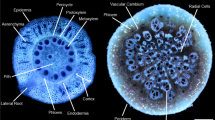Abstract
Expression of plant genes involved in the symbiosis between alfalfa (Medicago sativa) and Rhizobium meliloti has been studied by comparing root and root nodule mRNA populations. Two-dimensional gel electrophoretic separation of the in vitro translation products of polyA+ RNA isolated from either roots or effective root nodules has allowed us to identify thirteen nodule-specific translation products, including those corresponding to the leghemoglobins (Lb). These translation products, representing putative nodulin mRNAs, are first detected between 9 and 12 days after inoculation, a result which has been confirmed for Lb mRNA by Northern blotting and hybridization with a Lb cDNA probe. Analysis of three different types of ineffective root nodules arrested in different stages of development has led to the following conclusions. (i) The transcription of eleven nodule-specific genes, including the Lb genes, is independent of nitrogen-fixing activity. (ii) Differentiation of the primary nodule structure does not require the transcription of any of these genes but can be correlated with a dramatic reduction in the level of at least five transcripts present in the root. (iii) There is enhanced expression of certain plant genes in the case of nodules elicited by an Agrobacterium strain carrying the symbiotic plasmid of R. meliloti.
Similar content being viewed by others
References
Appleby CA: Leghemoglobin and Rhizobium respiration. In: Briggs WR (ed.) Ann Rev Plant Physiol 35: 443–478 (1984).
AusubelFM: Developmental genetics of the Rhizobium/legume symbiosis. In: LosickR, ShapiroL (eds) Microbial Development. Cold Spring Harbor, NY: Cold Spring Harbor Laboratory (1984) pp. 275–298.
BergmannH, PreddieE, VermaDPS: Nodulin 35: a subunit of specific uricase (uricase II) induced and localized in the uninfected cells of soybean nodules. EMBO J 2: 2333–2339 (1983).
BisselingT, BeenC, KlugkistJ, VanKammenA, NadlerK: Nodule-specific host proteins in effective and ineffective root nodules of Pisum sativum. EMBO J 2: 961–966 (1983).
BisselingT, GoversF, StiekemaW: Identification of proteins and their m-RNAs involved in the establishment of an effective symbiosis. In: MiflinBJ (ed) Oxford Surveys of Plant Molecular and Cell Biology, Vol. 1, Clarendon Press, Oxford (1984) pp. 53–83.
BonnerWM, LaskeyRA: A film detection method for tritium-labeled proteins and nucleic acids in polyacrylamide gels. Eur J Biochem 46: 83–88 (1974).
CoicY, Tendille, LesaintC: La nutrition azotée du tournesol (Helianthus annuus): action sur le rendement et la composition biochimique de la graine. Agrochimica 16: 254–263 (1972).
CullimoreJV, LaraM, LeaPJ, MiflinBJ: Purification and properties of two forms of glutamine synthetase from the plant fraction of Phaseolus root nodules. Planta 157: 245–253 (1983).
FeinbergAP, VolgelsteinB: A technique for radiolabeling DNA restriction endonuclease fragments to high specific activity. Anal Biochem 132: 6–13 (1983).
FinanTM, HirschAM, LeighJA, JohansenE, KuldauA, DeeganS, WalkerGC, SignerER: Symbiotic mutants of Rhizobium meliloti that uncouple plant from bacterial differentiation. Cell 40: 869–877 (1985).
FullerF, KünstnerPW, NguyenT, VermaDPS: Soybean nodulin genes: analysis of cDNA clones reveals several major tissue-specific sequences in nitrogen-fixing root nodules. Proc Natl Acad Sci USA 80: 2594–2598 (1983).
GoversFG, GloudemansT, MoermanM, VanKammenA, BisselingT: Expression of plant genes during the development of pea root nodules. EMBO J 4: 861–867 (1985).
GoversF, MoermanM, DownieJA, HooykaasP, FranssenHJ, LouwerseJ, VanKammenA, BisselingT: Rhizobium nod genes are involved in inducing an early nodulin gene. Nature 323: 564–566 (1986).
Lang-UnnaschN, AusubelFM: Nodule-specific polypeptides from effective alfalfa root nodules and from ineffective nodules lacking nitrogenase. Plant Physiol 77: 833–839 (1985).
LegockiRP, VermaDPS: Indentification of nodule specific host proteins (nodulins) involved in the development of Rhizobium-legume symbiosis. Cell 20: 153–163 (1980).
NutmanPS. Hereditary host factors affecting nodulation and nitrogen fixation. In: GibsonAH, NewtonWE (eds) Current Perspectives in Nitrogen Fixation. Elsevier, Amsterdam (1981) pp. 194–204.
O'FarrellPH: High resolution two-dimensional electrophoresis of proteins. J Biol Chem 250: 4007–4021 (1975).
PaauAS, CowlesJR: Development of bacteroids in alfalfa (Medicago sativa) nodules. Plant Physiol 62: 526–530 (1978).
Rochaix JD, Malnoe PM: Use of DNA-RNA hybridization for locating chloroplast genes and for estimating the size and abundance of chloroplast DNA transcripts. In: Edelman et al. (eds) Methods in Chloroplast Molecular Biology. Elsevier Biomedical Press (1982) pp. 477–490.
RolfeBG, ShineJ: Rhizobium-Leguminosae symbiosis: the bacterial point of view. In: VermaDPS, HohnTH (eds) Genes Involved in Microbe Plant Interaction, Springer-Verlag, Vienna, New York (1984) pp. 95–128.
RosenbergC, BoistardP, DénariéJ, Casse-DelbartF: Genes controlling early and late functions in symbiosis are located on a megaplasmid in Rhizobium meliloti. Mol Gen Genet 184: 326–333 (1981).
Sengupta-GopalanC, PitasJW: Expression of nodulespecific glutamine synthetase genes during nodule development in soybean. Plant Mol Biol 7: 189–199 (1986).
SzetoWW, ZimmermanJL, SundaresanV, AusubelFM: A Rhizobium meliloti symbiotic regulatory gene. Cell 36: 1035–1043 (1984).
TruchetG, RosenbergC, VasseJ, JulliotJS, CamutS, DénariéJ: Transfer of Rhizobium meliloti pSym genes into Agrobacterium tumefaciens: Host specific nodulation by atypical infection. J Bact 157: 134–142 (1984).
TurnerGL, GibsonAH: Measurement of nitrogen fixation by indirect means. In: BergersenFJ (ed.) Methods for Evaluating Biological Nitrogen Fixation, Wiley, Chichester (1980) pp. 111–138.
VanceCP, BoylanKLM, StadeS, SomersDA: Nodule specific proteins in alfalfa (Medicago sativa L.) Symbiosis 1: 69–84 (1985).
VanKammenA: Suggested nomenclature for plant genes involved in nodulation and symbiosis. Plant Mol Biol Reporter 2: 43–45 (1984).
VermaDPS, HauglandR, BrissonN, LegockiRP, LacroixL: Regulation of the expression of leghemoglobin genes in effective and ineffective root nodules. Biochim Biophys Acta 653: 98–107 (1981).
VermaDPS, NadlerK: Legume-Rhizobium-symbiosis: Host's point of view. In: VermaDPS, HohnTH (eds) Genes involved in Microbe Plant Interaction, Springer-Verlag, Vienna, New York (1984) pp. 57–93.
ZimmermanJL, SzetoWW, AusubelFM: Molecular characterization of Tn5 induced symbiotic (Fix-) mutants of Rhizobium meliloti. J Bact 156: 1025–1034 (1983).
Author information
Authors and Affiliations
Rights and permissions
About this article
Cite this article
Lullien, V., Barker, D.G., de Lajudie, P. et al. Plant gene expression in effective and ineffective root nodules of alfalfa (Medicago sativa). Plant Mol Biol 9, 469–478 (1987). https://doi.org/10.1007/BF00015878
Received:
Accepted:
Issue Date:
DOI: https://doi.org/10.1007/BF00015878




